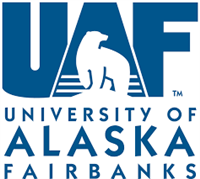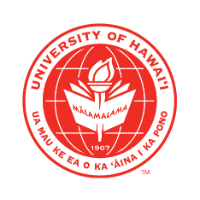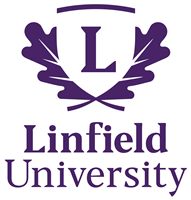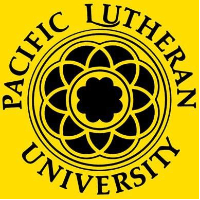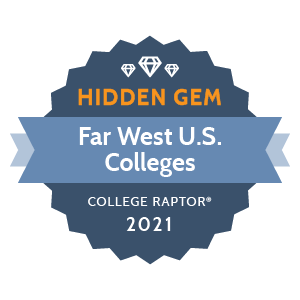 There is perhaps no region in the US more diverse than the Far West. There are snowy mountain ranges, rainy coasts, sunny beaches, tropical forests, broad deserts, and more. In addition to a variety of landscapes, the Far West is home to a variety of colleges.
There is perhaps no region in the US more diverse than the Far West. There are snowy mountain ranges, rainy coasts, sunny beaches, tropical forests, broad deserts, and more. In addition to a variety of landscapes, the Far West is home to a variety of colleges.
We wanted to highlight some of the small but mighty West Coast colleges. To qualify as a Hidden Gem, a school must meet the following requirements:
- Receive fewer than 5,000 applications
- Have fewer than 7,000 undergraduate students
- Have an acceptance rate above 10%
Additionally, we’re considering the following states as part of the far west: Alaska, California, Hawaii, Nevada, Oregon, and Washington.
We highlight the top 3 Hidden Gems per state. If a state has fewer than 3, it means no other schools met our criteria.
Here are the best West Coast colleges that are Hidden Gems!
ALASKA
Alaska Pacific University was founded in 1957 as a liberal arts and sciences college. Students attending can choose from 11 fields of study -- popular ones include Parks, Recreation, and Leisure Studies, Business Administration and Management, and Marine Biology and Biological Oceanography.The school has an 8:1 student-to-faculty ratio.
Location
Anchorage, AK
Institution Type
Private
Student Enrollment
502
Not only is the University of Alaska Fairbanks the flagship school for Alaska’s university system, it’s also a land-, sea-, and space-grant institution. Around 7,400 students currently attend this public research university. Every year, the university receives 1,300 applications -- students who are accepted typically have an ACT score between 19 to 26 and an SAT score between 980 to 1,260.
Location
Fairbanks, AK
Institution Type
Public
Student Enrollment
7,404
The University of Alaska Southeast is located in Juneau, Alaska, though it has two other campuses in Sitka and Ketchikan. First-year students will find that their classes will have around 10 students to every 1 faculty member. The University of Alaska Southeast’s mascot is Spike the humpback whale and the official school colors are blue and white.
Location
Juneau, AK
Institution Type
Public
Student Enrollment
2,266
CALIFORNIA
Harvey Mudd College is part of the Claremont Consortium, which means that students are free to use the resources the other schools in the consortium offer. Many students choose to major in fields such as Engineering, Computer Science, or Mathematics and Computer Science at Harvey Mudd.
Location
Claremont, CA
Institution Type
Private
Student Enrollment
902
Soka University of America is a unique school -- it offers one degree: Liberal Arts. Students can choose one of four tracks; students also participate in Learning Clusters and must study a language during their time at Soka University, culminating in a study abroad experience. With such a small student population, it’s no surprise that the average class size is eight students for every one faculty member.
Location
Aliso Viejo, CA
Institution Type
Private
Student Enrollment
442
Scripps College, an all-women’s college, is the second-oldest school in the Claremont Colleges. The school is known for its high selectivity, academic resources, and its beautiful campus. In fact, its campus was the first to receive the Getty Campus Heritage Initiative Program. Scripps College only accepts 24% of all applicants and has a 92% first-year retention rate.
Location
Claremont, CA
Institution Type
Private
Student Enrollment
1,071
97% borrower satisfaction shows our best in class customer service
Fixed rates from 3.99% - 13.75% APR with auto-debit
Learn More
HAWAII
Chaminade University of Honolulu was founded in 1955 and officially became a university in 1977. Today, over 2,100 students attend this private university and the school receives 1,500 applications annually. Around 98% of all attending students receive some form of grant aid. Criminal Justice/Safety Studies is the most popular major at the university.
Location
Honolulu, HI
Institution Type
Private
Student Enrollment
2,150
Originally a satellite campus, Brigham Young University -- Hawaii became an independent institution in 2004. Today, around 3,100 students attend the university and a third of the student body work at the Polynesian Cultural Center. Freshmen will find that many of their classmates are from either California or Utah and there’s a 17 to 1 student-to-faculty ratio.
Location
Laie, HI
Institution Type
Private
Student Enrollment
3,176
The University of Hawaii at Hilo is a public research university and was the first American university to offer a graduate program for an indegenous language. Its motto is “Pulelo haʻaheo ke ahi a nā lehua aʻo Hilo,” which translates to “The flame of Hilo's lehua blossoms leaps triumphantly with pride.”
Location
Hilo, HI
Institution Type
Public
Student Enrollment
3,406
NEVADA
Almost 900 students currently attend Sierra Nevada, and the university receives over 800 applications every year. 64% of the 800 applicants are accepted. Around 99% of all students receive grant aid and 98% receive institutional aid. A third of the freshman class is from California. The university’s mascot is Eli the American Eagle.
Location
Incline Village, NV
Institution Type
Private
Student Enrollment
889
Nevada State College was established in 2002 as the first state college in Nevada. Around 4,900 students currently attend and the college receives over 1,300 applications annually. The most popular major studied at the college is Registered Nursing, followed by Psychology and Business Administration and Management.
Location
Henderson, NV
Institution Type
Public
Student Enrollment
4,930
OREGON
Willamette University has a long and colorful history as the oldest university in western America and the first university to establish a medical and law school in the Pacific Northwest. Today, the university has over 2,300 attending students and receives over 4,200 applications annually. Incoming students have an average ACT score between 24 to 29 and an SAT score between 1,160 to 1,360.
Location
Salem, OR
Institution Type
Private
Student Enrollment
2,363
Linfield University, previously known as Linfield College, was initially called the Baptist College at McMinnville and then McMinnville College before settling on its current name. Around 2,300 students apply to the university annually -- incoming students typically score between 20 to 26 on the ACT and 1,040 to 1,240 on the SAT. Over half of the freshman class is from Oregon.
Location
McMinnville, OR
Institution Type
Private
Student Enrollment
1,376
Though the university is known for its extensive optometry programs, students have over 40 majors to choose from. The most popular major offered is Business Administration and Management, followed by Kinesiology and Biology. Around 98% receive some form of institutional aid. The university’s mascot is the Boxer.
Location
Forest Grove, OR
Institution Type
Private
Student Enrollment
3,938
WASHINGTON
Whitman College was founded in 1859 and was the first college in the Pacific Northwest to have a Phi Beta Kappa Chapter, as well as the first school in America to require comprehensive exams if students wanted to graduate. Today, almost 1,500 students attend Whitman College, many of whom major in fields such as Biology, Psychology, and Economics.
Location
Walla Walla, WA
Institution Type
Private
Student Enrollment
1,475
The University of Washington -- Bothell Campus is home to over 5,900 students and hosts the largest wetlands restoration projects in the west coast. Students attending the university enjoy a multitude of majors -- some popular ones include Business Administration and Management, Registered Nursing, and Computer Science.
Location
Bothell, WA
Institution Type
Public
Student Enrollment
5,970
Pacific Lutheran University was founded by Norweigan Lutherans and to this day, the university honors its Scandanavian roots.The school has over 30 different majors for students to choose from -- popular ones include Business Administration and Management, Registered Nursing, and Kinesiology.
Location
Tacoma, WA
Institution Type
Private
Student Enrollment
3,207
Interested in any of these schools? Check out College Raptor’s free match tool to see if they’re a good fit for you!
Methodology
Colleges are ranked based on a combination of factors, including graduation rates, campus diversity, endowment per student, and other data as reported via the National Center for Education Statistics (NCES) for the most recently-available enrollment year. Some colleges may have been excluded from rankings based on certain criteria, including specialization and classification. Learn about our full methodology.
 There is perhaps no region in the US more diverse than the Far West. There are snowy mountain ranges, rainy coasts, sunny beaches, tropical forests, broad deserts, and more. In addition to a variety of landscapes, the Far West is home to a variety of colleges.
There is perhaps no region in the US more diverse than the Far West. There are snowy mountain ranges, rainy coasts, sunny beaches, tropical forests, broad deserts, and more. In addition to a variety of landscapes, the Far West is home to a variety of colleges.
